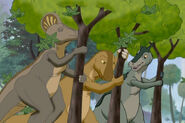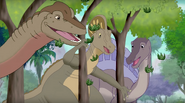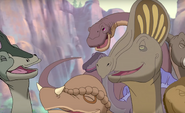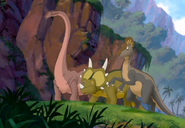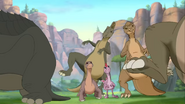Corythosaurus was a late Cretaceous hadrosaur that lived in what is now North America, about 77-76.5 million years ago.[1]
Description[]

Size of C. casuarius (left, red) and C. intermedius (right, yellow) compared to a human.
It was about 30–33 feet long from nose to tail, weighed in at 4 tonnes, and had a circular crest on its head formed from long nasal passages,[2] in the shape of a helmet flattened on the sides (Corythosaurus means "helmet lizard"). Males had larger crests than females and juveniles. Like all hadrosaurs it could switch between two legs and four. The beak of Corythosaurus had no teeth, but the back of the jaws had hundreds. These were used to crush and grind plants and when teeth were lost, it grew new ones.
More than 20 skulls have been found from this dinosaur. As with all lambeosaurs, it bore a tall, bony crest on top of its skull, which had the long nasal passages.[2]
Classification[]

ROM 870, the skull of a subadult, originally named as a separate species, C. brevicristatus
Corythosaurus is classified as a hadrosaurid, in the subfamily Lambeosaurinae. It is related to other hadrosaurs such as Hypacrosaurus, Lambeosaurus and Olorotitan, aside from Olorotitan, they all share similar looking skulls and crests. But, recent research has shown that Olorotitan is Corythosaurus closest known relative even though it lacks most of the skull traits of most lambeosaurs.[3]

ROM 845, mounted skeleton of Corythosaurus cf. intermedius cf. excavatus Parks 1935 at the Royal Ontario Museum
History[]

Fossil holotype specimen AMNH 5240 partially covered in skin impressions
The first specimen was discovered in 1912 by Barnum Brown in Red Deer River, Alberta.[4] Fossils have been found in the upper Oldman Formation and lower Dinosaur Park Formation of Canada.[1]
Paleobiology[]

Outdated 1916 restoration showing C. casuarius as semi-aquatic
Its nasal passages extended to the crest, first to separate pockets in the sides, then into a central chamber in the respiratory system.[2]
Any vocalization would go through these chambers, and probably get louder.[2] Scientists think that Corythosaurus could make loud, low pitched cries "[L]ike a wind or brass instrument."[2] The sounds could serve to alert other Corythosaurus if they found food or saw a predator.[2]
It was once thought that this dinosaur lived most of its time in the water, due to the webbed hands and feet. However, it was later found that the so-called "webs" were in fact deflated padding, much like that found on many modern mammals.
The bony rings in Corythosaurus's eyes were compared to those of modern birds and reptiles, which shows that it may have been active through the day at short times.[5]
Corythosaurus in The Land Before Time[]
Corythosaurus are known as Hollowhorns in the Land Before Time series, along with other large-crested hadrosaurs (lambeosaurines). They are seen as background characters in many movies and episodes, starting with The Land Before Time V: The Mysterious Island. The opening of The Big Freeze reveals that they use their crests to whistle. Most Corythosaurus in the Land Before Time are colored in shades of brown and grayish brown with light underbellies, varying from rich to dull. The character of Ducky has been confused for a Corythosaurus.
Gallery[]
Audio Facts[]
From The Land Before Time Animated Moviebook:
- This dinosaur is best known for the helmet-shaped crest mounted on its head.
- This dinosaur ate plants as its main source of food.
- Some scientists believe that the unusually shaped crest was used as a way to identify members of a herd.
- This dinosaur’s name means "helmet lizard."



